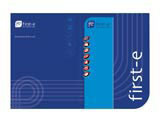Putting it all on the line
As high street bank branches close, pioneering banks set up on-line, with user-friendly interfaces. But, as Mike Exon finds out, some consumers aren’t ready for Internet banking

Traditional high-street banks are closing branches, despite fighting for space in the banking sector. The future, we are told, is not in retail banking.
It could be seen as slightly ironic that two of the most ambitious players in digital banking, HSBC and Citigroup, unveiled bricks and mortar designs for a pair of skyscrapers at Canary Wharf in London this week.
The low overheads of direct banking have given rise to a new breed of bank brands, from Egg to Sainsbury’s. Other new names like First-e, Smile and Marbles are launching on the Web, rather than on the phone. As Midland (now HSBC) proved with First Direct, home banking is easier for the customer. Now it can only get easier still with TV banking and wireless technology (WAP) via mobile phones.
As the sector expands, expect the direct banks to offer on-line services and telephone banking. Sainsbury’s Bank and Tesco Personal Finance both confirm plans to extend Web trials to full banking services in the near future.
First Direct, which pioneered PC banking in conjunction with design group Nucleus, is expected to roll out Web services this year and claims 10 per cent of its customers already use PC banking.
Just as high-street banks have crossed into home banking, and direct banks have crossed into on-line banking, now Internet-only banks, operating almost entirely on-line, are muscling in too.
First-e claims to be the first pan-European Internet-only bank, currently offering on-line savings accounts. It plans to launch current account and merchant banking facilities soon. First-e is backed by the likes of Intel, Apax Partners, Morgan Stanley and Commercial Union. Design consultancies Equation and Real Design are developing on-line branding and Myriad Creative is working on its print work.
First-e chief executive Xavier Azalbert challenges the existing banking system and has already set up the facility for the instant transfer of funds between First-e customers, rather than a three-day clearing period used in other UK banks.
Azalbert says high-street banks are going on-line by simply putting “www” before their names. He says First-e is different because it has a back-office setup designed for home banking, passing cost savings on to customers.
“Design is completely fundamental. When you only have a virtual presence, you need to put a lot of emphasis on the client interface. Both the graphics and the ease of use are critical. As soon as customers log on they get, in one eyeball, what it takes minutes to find out by phone.”
The Co-operative Bank launched Smile.co.uk last week, with branding and Internet design overseen by The Chase in Manchester. However, neither that group nor the Web design consultancy also involved were able to comment on the project.
Plenty of other launches are expected too. Wolff Olins was brand consultancy for last week’s Internet credit card launch, Marbles, by HFC Bank. Web development was managed by Entranet.
“We think that the banks and credit cards that are coming out simply on-line are missing what customers want. With our account you can apply on-line and run the entire account on-line, but people want a regular card they can use in the high street as well. It is about flexibility,” says a spokesman for Marbles.
Nucleus digital strategy director Stephen Byrne says the US is still way ahead of the UK in terms of website design and functionality. “UK banks are between two and three years behind their US counterparts. For example, Wells Fargo already has its on-line banking available through Web TV and mobile communications such as personal digital assistants and digital phones. Most banking will be done via mobiles using cards in the next two years.
“Many US retail and private banks have got innovation and subsequent development times down to a fine art. They know what their customers are doing and understand their motivations.
“The challenge for UK banks is how they make what have been traditional high-street operations into true digital businesses. Even Egg didn’t start that way. It thought people would be doing phone banking first.”
There are stark warnings too for UK Internet banks. In August, Internet research group Fletcher Research published the following findings: “The biggest problem may prove to be consumer apathy. Only about 7 per cent of British adults who regularly use the Internet currently bank on-line, compared with 10 per cent of Americans and a remarkable 35 per cent of Germans.” It noted that banks are forced to compete by offering attractive, loss-making interest rates in the UK.
Home banking via the Internet and new digital channels would appear to be an unstoppable force. But there are cautionary voices too. Cynics point to the existing banking system and its glut of imperfections, like three-day clearing, which have been sustained by traditional banks to their advantage.
With luck, the regulatory shake up being handled by Don Cruickshank, appointed by HM Treasury to chair a national banking review, will clear the way for a steady stream of new initiatives involving ripe opportunities for design consultancies.
-
Post a comment




